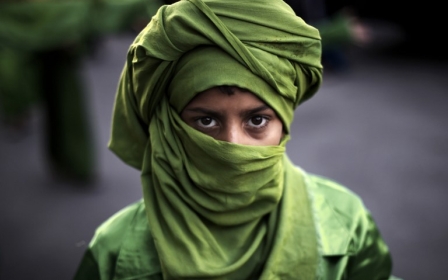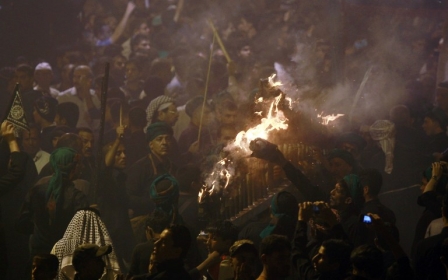Ashura celebrations mask memories of sorrow for Shiite Muslims
This week marks the festival of Ashura, a holy day in the Muslim calendar, celebrated and commemorated by millions worldwide.
Seen as holy to both Sunnis and Shiites, the day has different symbolisms for Islam's two main groups.
For Sunnis, Ashura marks the 10th of Muharram, the first month of the Islamic calendar and commemorates the day - which they also call The Day of Atonement - when the Israelites were freed from the Pharaoh in Egypt. This year it was marked on Monday 3 November.
Some Sunnis following in the footsteps of Prophet Moses who they believe fasted on that day to express gratitude to God for liberating the Israelites from Egypt, an event commonly known as the Exodus.
Hundreds of years after the life of Moses, the prophet Muhammad, according to Sunni religious tradition, travelled to Madina and encountered Jews fasting on the tenth day of Muharram.
He asked why they were fasting and was they told him, “This is a good day. This is the day when Allah saved the Children of Israel from their enemy and Musa (Moses) fasted on this day.”
Hearing of this, Muhammad fasted and requested his followers to also fast – though the tradition of fasting on this day is not maintained in Judaism.
Although it is a significant day for all Muslims, Ashura is primarily associated with Shiite Islam, particularly due to the high visibility of the rituals (often, depending on the region, involving self-flagellation and walking on hot coals) and demonstrations associated with it and the high political significance it has held for many Shiites.
For Shiites, the day marks a moment of loss and sacrifice – less a celebration, than a day of mourning - commemorating the martyrdom of Imam Hussein ibn Ali, the grandson of the Prophet Muhammad, at the Battle of Kerbala.
“The stories are known to every individual taking part in the ritual, whether as performer or spectator,” wrote Faleh Jabar, a Research Fellow at Birkbeck College, University of London.
“It is the journey of Hussein to Kerbala to regain his deserved caliphate. He is betrayed by supporters; outflanked and outnumbered by a brutal enemy; cut off from water; left almost alone with a few loyal supporters, a stranger in a foreign land with his children and his sister.”
In Shiite Islam, the notion of Ahl al-Bayt (People of the House) is a central theme and signifies the major split from Sunni Islam – the belief in the prominence of the Prophet’s family and bloodline in the Islamic community.
In this light, the death of Hussein, at the orders of Yazid I, the caliph of the Umayyad Caliphate, marks a tragedy in the Shiite calendar.
“We feel that what happened to the prophet’s grandson was a great injustice and it was completely against the ethos of the prophet’s message and against his respect for him and love for him and his family,” said Huda Jawad, an Advisor at the Centre for Academic Shi'a Studies.
Speaking to Middle East Eye, she described the importance of the notion of martyrdom and the lasting legacy of Imam Hussein’s sacrifice, in marking Ashura.
“I think it’s one of the main iconic themes and I think in any religious system you will see martyrdom or the notion of sacrifice is a very important one because it not only touches upon the physical sense of sacrifice, but also the sacrifice of world desires and trying to move beyond the individual and foster a sense of community, a sense of responsibility for others so that you may do things for the greater good,” she said.
The city of Kerbala in Iraq contains the Imam Hussein shrine, marking the spot where Hussein fell in the Battle of Kerbala.
Along with the shrine of Imam Ali in Najaf, the Imam Hussein shrine is among the holiest locations for Shiites, outside of the Muslim holy cities of Mecca, Medina and Jerusalem (Al-Quds).
In spite of this, for much of the 20th and early 21st century, the Shiite Ashura celebrations were restricted by former Iraqi President Saddam Hussein.
The overthrow of Saddam Hussein by the US-led coalition in 2003 – and the rise to power of Shiites within the Iraqi government – led to newfound freedoms for Shiite worshippers in Iraq, with millions attending the first post-Saddam Ashura pilgrimage to Kerbala in 2004.
“I think it was a massive watershed moment, really, because it was a massive public global declaration that ‘we are Shiites and we are here to stay,’” says Jawad.
“The sheer number of people was frightening, not just those of Iraqi origin, but all those Shiites that came from across the globe and in the neighbouring countries and for the regional governments and regimes of the time, it was one of the most scary moments for them. Since then you’ve had very clear and public condemnations and very clear sectarian rhetoric by all ruling governments of that region.”
She told MEE that it was a demonstration of defiance, in one of the Middle East's only three Shiite-majority countries, and a symbol of the rejection of oppressive minority-rule.
“This was a historical moment in time when we said this was never, ever going to happen again in Iraq.”
However, the 2004 Ashura commemorations in Iraq were also a precursor of the vicious sectarian violence that would come to grip the country directed by al-Qaeda in Iraq which at that time killed 178 worshippers, 100 in Kerbala and 78 in Iraq.
“Globally, the threat of violence against Shiites during Ashura is immense,” said Jawad, who is based in the UK.
Highlighting the attack on Shiites by followers of the Salafist preacher Anjem Choudary in London in 2013, and the rise in sectarian violence globally, partly as a result of the rise of the Islamic State, she said that Ashura celebrations in London were being prepared with particular caution.
“People I know on social media are asking ‘when is it our turn, when is it happening in the UK?’ So there’s extra security when we organise the marches”, she said.
“We usually carry black flags to commemorate and express our devotion and grief. We were advised against doing that this year because people assume the black flag is [Islamic State]. So you’ll see people with white flags or green flags now, instead of black - you have to really think about the way you express solidarity and grief as a Shiite, because of that geopolitical context.”
In Sydney, Australia, that backdrop was made much more explicit at the Ashura demonstrations on Tuesday, where a procession of more than 2,000 people was led by a banner denouncing IS.
“Oppressors attacked Jesus Christ to crucify him, but he was victorious,” it read. “After centuries, similar people attacked Imam Hussein to demolish truth and justice, but he was victorious.”
“Today, terrorists have risen again. Who will be victorious over them?”
Speaking to the Guardian, Husayn al-Ramadani, who was on the Sydney march, drew parallels between the death of Hussein and the conflict with sectarian groups like IS.
“Hussein was massacred by people who believed they are Muslims, who believed they are the true Islam. Similarly if you asked members of ISIS, they’d say they are on the right path,” he said.
“Sadly they’re misguided. Our religion has been hijacked by thugs.”
New MEE newsletter: Jerusalem Dispatch
Sign up to get the latest insights and analysis on Israel-Palestine, alongside Turkey Unpacked and other MEE newsletters
Middle East Eye delivers independent and unrivalled coverage and analysis of the Middle East, North Africa and beyond. To learn more about republishing this content and the associated fees, please fill out this form. More about MEE can be found here.




